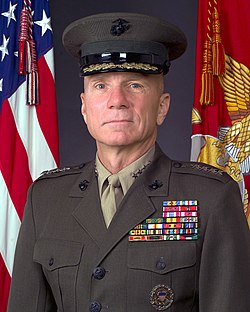Michael Hagee | |
|---|---|
 Official portrait, 2003 | |
| Born | December 1, 1944 Hampton, Virginia, U.S. |
| Allegiance | United States |
| Service | United States Marine Corps |
| Years of service | 1968–2007 |
| Rank | General |
| Commands | Commandant of the Marine Corps 1st Marine Expeditionary Force 1st Marine Division 1st Marine Division 11th Marine Expeditionary Unit 1st Battalion 8th Marines |
| Battles / wars | Vietnam War Gulf War |
| Awards | Defense Distinguished Service Medal (3) Defense Superior Service Medal Legion of Merit (3) Bronze Star Medal National Intelligence Distinguished Service Medal |
Michael William Hagee (born December 1, 1944) is a retired United States Marine Corps four-star general who served as the 33rd Commandant of the Marine Corps from 2003 to 2006, succeeding General James L. Jones on January 13, 2003. He stepped down as Commandant two months before the end of his four-year term, and was succeeded by General James T. Conway on November 13, 2006. [1] On that date, Hagee had his retirement ceremony just prior to the passage of command ceremony. [2] Hagee retired from the Marine Corps on January 1, 2007. [3]

